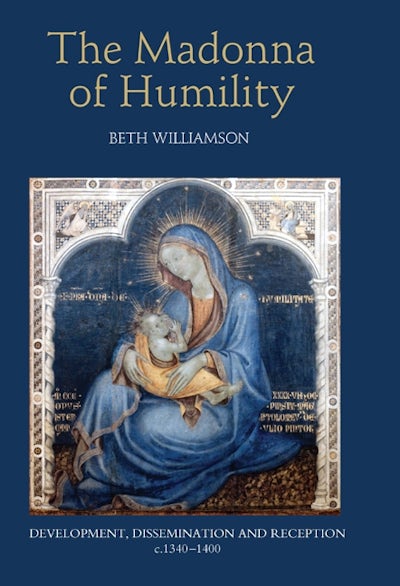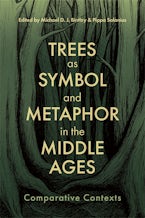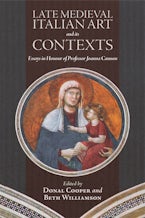
Title Details
212 Pages
24.4 x 17.2 cm
8 colour. 40 b/w.
Series: Bristol Studies in Medieval Cultures
Series Vol. Number:
1
Imprint: Boydell Press
The Madonna of Humility
Development, Dissemination and Reception, c.1340-1400
- Description
- Contents
- Author
- Reviews
Detailed analysis of an iconographic motif of huge significance in European art.
The image of the `Madonna of Humility', the Virgin and Child seated on the ground, is widespread in European art, yet it remains mysterious. This book provides a detailed and accessible investigation and explication of the theme'smultiple significances, and of other associated images (including the Virgin suckling the Child, the Woman of the Apocalypse and the Virgin Annunciate). It takes issue with the orthodox view of the origins of the image lying in the work of Simone Martini at Avignon, suggesting a longer process of development, with a key role for manuscript illumination in Metz. Subsequent chapters pursue the assimilation, appropriation, and adjustment of the image in a number of regions across Europe, challenging the simplistic idea of unequivocal iconographic meaning determined solely by the context of the image's genesis. The book argues for an essential fluidity and negotiability of meaning inthe visual arts, challenging the very idea of unitary and unequivocal iconographic readings; and its examination of the multi-layered functions of the image in different contexts and different regions provides not just an iconographical case-study, but a cultural history of a devotional resource with Europe-wide implications
Dr BETH WILLIAMSON teaches in the Department of Art History, University of Bristol.
The image of the `Madonna of Humility', the Virgin and Child seated on the ground, is widespread in European art, yet it remains mysterious. This book provides a detailed and accessible investigation and explication of the theme'smultiple significances, and of other associated images (including the Virgin suckling the Child, the Woman of the Apocalypse and the Virgin Annunciate). It takes issue with the orthodox view of the origins of the image lying in the work of Simone Martini at Avignon, suggesting a longer process of development, with a key role for manuscript illumination in Metz. Subsequent chapters pursue the assimilation, appropriation, and adjustment of the image in a number of regions across Europe, challenging the simplistic idea of unequivocal iconographic meaning determined solely by the context of the image's genesis. The book argues for an essential fluidity and negotiability of meaning inthe visual arts, challenging the very idea of unitary and unequivocal iconographic readings; and its examination of the multi-layered functions of the image in different contexts and different regions provides not just an iconographical case-study, but a cultural history of a devotional resource with Europe-wide implications
Dr BETH WILLIAMSON teaches in the Department of Art History, University of Bristol.
Introduction
The Madonna of Humility: Descriptions and Definitions
The Madonna of Humility in Avignon
Early Appearances of the Image
Bohemia
Siena and Florence
Image and Ideal
Using the Madonna of Humility
Responding to the Madonna of Humility
Conclusion
Bibliography
The Madonna of Humility: Descriptions and Definitions
The Madonna of Humility in Avignon
Early Appearances of the Image
Bohemia
Siena and Florence
Image and Ideal
Using the Madonna of Humility
Responding to the Madonna of Humility
Conclusion
Bibliography
"Provides a valuable contribution to the study of the art of the fourteenth century [and] a welcome art-historical contribution to the recent resurgence of interest in the Virgin Mary." CAA REVIEWS
"A beautifully crafted study that attempts to more firmly weave together the historical and art historical, and Williamson's argument, in the introduction, for such interdisciplinary is most forcefully conveyed through the success of the monograph as a whole." COMITATUS
"A well-written, convincing work of art history. [...] Provides food for thought for those who are tempted either to ignore images in their historical research, or make easy assumptions about their use, reception, and interpretation." H-NET REVIEWS
"[A] substantial and meticulously researched study. [...] Far from closing debates on the Madonna of Humility, Beth Williamson has opened up the reading of the image type in its devotional context in a stylish, beautifully written and thought- provoking study." THE MEDIEVAL REVIEW
"In its engagement with fresh methodology and diverse visual and textual sources, the book will be interesting to art historians generally and medievalists specifically." SOUTHWEST JOURNAL OF CULTURES
"The University of Bristol is to be congratulated on this latest contribution to its series of works on mediaeval culture. A satisfying study, underlining the point that while individual works need to be placed in context, they stand, or fall, simply on their own merit." CHRISTOPHER COLVEN, THE ART NEWSPAPER
Hardcover
9781843834199
February 2009
$115.00 / £75.00
Title Details
212 Pages
2.44 x 1.72 cm
8 colour. 40 b/w.
Series: Bristol Studies in Medieval Cultures
Series Vol. Number:
1
Imprint: Boydell Press






















